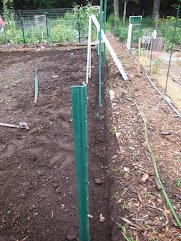 |
| Before we began managing the Community Garden, plots would routinely be abandoned, like this one from 2008. |
This week, after almost twelve years, I came to the belated realization my wife and I are running the gardening equivalent of a pet adoption service.
 |
| In March and April, garden plots are like kittens and puppies: everyone wants one. |
What’s wrong with an older animal? Sure, they’re still
attractive, but you know from experience there are going to be vet bills,
litter tracks in the laundry room, chewed shoes, and inexplicable sullen moods.
Adult pets are a hard sell.
Above: a June 2021 flyover of the Medfield Community Garden
Now, think about this: Every February and March, we announce
the availability of our town’s 80 community garden plots. Returning gardeners
and would-be newbies beat a path to our door to sign up. They uniformly have
vision of lush, verdant plots overrun with pestilence-free zucchini, tomatoes,
beans, and herbs. Humans, it seems, have a love affair with the gardens they
have not yet planted.
Even in May and June, if a gardener finds his or her plans
have changed, filling the space is as simple as putting out an announcement to
existing plot-holders that an additional space is available. We choose a
replacement by lottery from as many as a dozen applicants.
But, what about July?
That is another story.
No explanation. Not even a ‘sorry to leave you in the lurch’
post script. Just a 600-square-foot
space with weeds. The fence had been taken down and the vegetables removed.
 |
| I had told the gardener the plot was getting weedy; the gardener disagreed |
No matter the reason, we were left with the equivalent of a
middle-aged dog or cat. The question on the table was, how do we make this
animal adoptable?
The key problem is called ‘growing season days remaining’. The
community garden nominally closes down October 31 but, by then, we’ve had a
couple of hard frosts. The first frost can come in mid-September by which time
we’re down to 12 hours of daylight (versus 16 right now). In short, the
remaining growing season is 60-65 days.
Not to mention you can’t buy (short of emptying your IRA) fencing
or stakes in July. Or plants. Or any seed package you’d be proud to
plant. We didn’t have just a middle-aged dog on our hands: we had one with
arthritis, worms, and a heart murmur.
 |
| The garden has been weeded, and has a fresh fence |
Today, the fence went up. Tomorrow morning, there will be a
gate and a fresh wood-chipped path around the garden border. Work investment?
Between the two of us, about twelve hours of very hard and sweaty labor.
Then, I will start the process of giving it away. Not all of it to one person: no one is willing
to make that investment in energy.
Instead, it will be offered in pieces: a place for a 6’x10’ square of
corn. A mound for pumpkins. A sheltered
fence line for lettuce or beets. A good
community garden manager keeps a mental inventory of plot holders who have
sighed and said, “If I only had a little more sunlight…” or “I would love to
grow tomatillos but they take so much space…”
 |
| Pumpkins are one option |
A fair question to ask is why I didn’t see it coming. I sort
of did. I regularly walk the paths of the garden’s acre-plus and look in on
each of the 80 plots. I check for a lot of things but, mostly, I check for
effort. I am the Garden Ogre, but I try
to be a patient ogre. We’re all volunteers here. I nudge, I cajole, I offer
encouragement. I don’t want to throw people out of the garden; I want them to
abide by the garden’s guidelines, enjoy themselves, and come back next year.
 |
| Most of my Ogre-grams are fairly gentle. This one was intended to get immediate action. Instead, I got an 'out of office' reply. |
No, they didn’t, but I had put the gardener on notice. Two
weeks later, part of the garden was covered with cardboard, but the uncovered
area was just as weedy. Another photo and missive went out; this one saying the
weeds needed to be taken care of immediately. I received an ‘out of office’
reply with a return date a week off.
Upon the gardener’s return, the weeds were noticeably reduced.
But so, too, were the plantings: all that remained were some tomatoes and
beans. That should have been the ‘tell’. Four days later came the ‘we don’t
need it anymore’ note.

